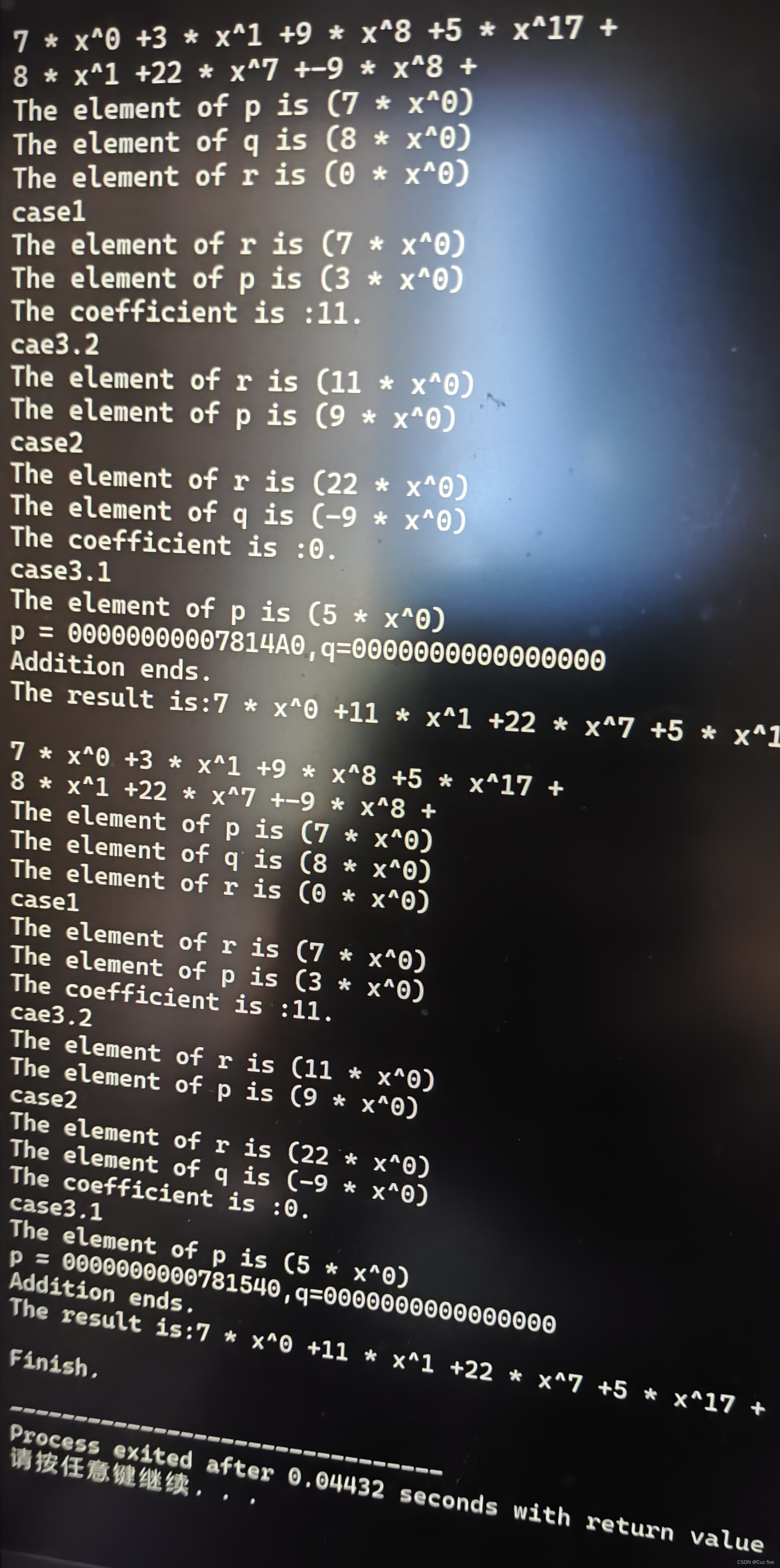1.代码
#include <stdio.h>
#include <malloc.h>
/**
* Linked list of intgers.The key is data.The key is sorted in non-descending order.
*/
typedef struct LinkNode{
int coefficient;
int exponent;
struct LinkNode *next;
}*LinkList,*NodePtr;
/**
* Initialize the list with a header.
* @param The pointer to the list.
*/
LinkList initLinkList(){
LinkList tempHeader=(LinkList)malloc(sizeof(struct LinkNode));
tempHeader->coefficient = 0;
tempHeader->exponent = 0;
tempHeader->next = NULL;
return tempHeader;
}//of initLinkList
/**
*Print the list
*@param paraHeader The header of the list.
*/
void printList(LinkList paraHeader){
NodePtr p = paraHeader->next;
while(p!=NULL){
printf("%d * x^%d +",p->coefficient,p->exponent);
p=p->next;
}//of while
printf("\r\n");
}//of printList
/**
*Print one node for testing.
* @param paraPtr The pointer to the node.
* @param paraChar The name of the node.
*/
void printNode(NodePtr paraPtr,char paraChar){
if(paraPtr ==NULL){
printf("NULL\r\n");
}
else{
printf("The element of %c is (%d * x^%d)\r\n",paraChar,paraPtr->coefficient);
}//of if
}//of printNode
/**
*Add an element to the tail.
*@param paraCoefficient The coefficient of the new element.
*@param paraExponent The exponent of the new element.
*/
void appendElement(LinkList paraHeader,int paraCoefficient,int paraExponent){
NodePtr p,q;
//Step1.Construct a new node.
q=(NodePtr)malloc(sizeof(struct LinkNode));
q->coefficient = paraCoefficient;
q->exponent=paraExponent;
q->next=NULL;
//Step2.Search to the tail.
p=paraHeader;
while(p->next!=NULL){
p=p->next;
}//oif while
//Step3.Now add/link
p->next=q;
}//of appendElement
/**
*Polynomil addition.
*@param paraList1 The first list.
*@param paraList2 The second list.
*/
void add(NodePtr paraList1,NodePtr paraList2){
NodePtr p,q,r,s;
//Search to the position.
p=paraList1->next;
printNode(p,'p');
q=paraList2->next;
printNode(q,'q');
r=paraList1;
//Previous for inserting.
printNode(r,'r');
free(paraList2);//The second list is destoryed.
while((p!=NULL)&&(q!=NULL)){
if(p->exponent<q->exponent){
//Link the current node of the first list.
printf("case1\r\n");
r->next=p;
r=p;
printNode(r,'r');
p=p->next;
printNode(p,'p');
}
else if((p->exponent>q->exponent)){
//Link the current of the second list.
printf("case2\r\n");
r->next=q;
r=q;
printNode(r,'r');
q=q->next;
printNode(q,'q');
}
else
printf("case3\r\n");
//Change the current node of the first list.
p->coefficient=p->coefficient+q->coefficient;
printf("The coefficient is :%d.\r\n",p->coefficient);
if(p->coefficient==0){
printf("case3.1\r\n");
s=p;
p=p->next;
printNode(p,'p');
free(s);
}
else{
printf("cae3.2\r\n");
r=p;
printNode(r,'r');
p=p->next;
printNode(p,'p');
}//of if
s=q;
q=q->next;
//printf("q is pointing to(%d %d )\r\n",q->coefficient,q->exponent);
free(s) ;
}//of if
printf("p = %p,q=%p\r\n",p,q);
if(p==NULL){
r->next=q;
}
else{
r->next=p;
}//of if
printf("Addition ends.\r\n");
}//of add
/**
*Unit1
*/
void additionTest1(){
//Step1.Intialize the first poiynomil.
LinkList tempList1 = initLinkList();
appendElement(tempList1,7,0) ;
appendElement(tempList1,3,1) ;
appendElement(tempList1,9,8) ;
appendElement(tempList1,5,17) ;
printList(tempList1);
//Step2.Initialize the second polynomil.
LinkList tempList2=initLinkList();
appendElement(tempList2,8,1) ;
appendElement(tempList2,22,7) ;
appendElement(tempList2,-9,8) ;
printList(tempList2);
//Step3.Add them to the first.
add(tempList1,tempList2) ;
printf("The result is:");
printList(tempList1);
printf("\r\n");
}//of additionTest1
/**
*Unit2
*/
void additionTest2() {
//Step1.Intialize the first poiynomil.
LinkList tempList1 = initLinkList();
appendElement(tempList1,7,0) ;
appendElement(tempList1,3,1) ;
appendElement(tempList1,9,8) ;
appendElement(tempList1,5,17) ;
printList(tempList1);
//Step2.Initialize the second polynomil.
LinkList tempList2=initLinkList();
appendElement(tempList2,8,1) ;
appendElement(tempList2,22,7) ;
appendElement(tempList2,-9,8) ;
printList(tempList2);
//Step3Add them to the first.
add(tempList1,tempList2) ;
printf("The result is:");
printList(tempList1);
printf("\r\n");
}//of additionTest2
/**
*The entrance
*/
int main(){
additionTest1();
additionTest2();
printf("Finish.\r\n");
return 0;
}//of main2.运行结果

3.小结
数据结构中的多项式加法,实际上是对多项式的系数进行相应的操作,而不是直接对数据结构本身进行加法。在多项式的数据结构表示中,通常使用数组或链表来存储多项式的系数和对应的指数。多项式加法的核心步骤是逐项相加同类项,即指数相同的项。
数据结构选择:
数组:适用于多项式项数固定或已知最大项数的情况。数组的每个元素代表一个项,通常包含系数和指数两部分信息。
链表:适用于多项式项数不固定或需要动态增减项的情况。链表的每个节点代表一个项,同样包含系数和指数。
加法操作:
1.初始化:创建一个新的数据结构(数组或链表)来存储加法结果。
2.遍历:同时遍历两个多项式的每一项。
3.比较指数:对于当前遍历到的项,比较它们的指数。
如果指数相同,则将两个项的系数相加,并将结果存储到新数据结构的对应位置。
如果指数不同,则将系数较小的项直接复制到新数据结构中,并继续遍历下一个项。
4.处理剩余项:当一个多项式遍历完后,将另一个多项式剩余的项直接复制到新数据结构





















 3415
3415

 被折叠的 条评论
为什么被折叠?
被折叠的 条评论
为什么被折叠?








